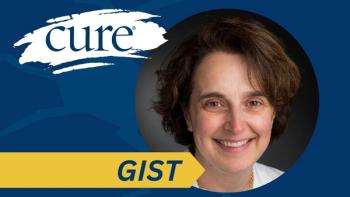
Getting the Gist on GIST
In a recent interview with CURE®, an expert from Fox Chase Cancer Center discussed gastrointestinal stromal tumors (GIST) and addressed a multitude of topics including common symptoms associated with the disease, and potential future therapies that may be beneficial for patients.
Rare cancers, such as gastrointestinal stromal tumors (GIST), rarely get the same attention as more commonly diagnosed cancers including lung cancer, breast cancer and colon cancer. However, developments surrounding a rare cancer can thrust that disease into an area where more people are talking about it.
Last year, the Food and Drug Administration (FDA) approved two new therapies —
Recently, CURE® spoke with Dr. Margaret von Mehren, chief of the Division of Sarcoma Medical Oncology at Fox Chase Cancer Center in Philadelphia, and discussed what GIST is, how the disease presents, where it may spread and much more.
CURE®: What are gastrointestinal stromal tumors and how frequently is this cancer diagnosed?
von Mehren: They are cancers of cells in the gastrointestinal tract. We believe that most of these tumors arrive from cells called the interstitial cells of Cajal, which simplistically are sort of the pacemaker cells of the gut. They're the things that cause the gut to continually squeeze and propel things forward throughout the intestine.
So, these tumors are most frequently found in the stomach, followed by the small intestine, but they really can be found anywhere in the intestinal tract, and occasionally outside, but those are very rare. Overall, in terms of numbers of new cases, in the United States, we think that new cases are about 5,000 or so a year. They are considered rare tumors.
How difficult has it been to conduct research to try and find new treatment options for patients since this disease is relatively rare?
Before 2000, it was probably very hard in part because as a disease entity, (GIST) wasn't really known and clearly identified by all pathologists. What really changed, in about 2000, was the identification of certain genes that were altered or mutated, (which) causes the cells that have these changes to become cancerous. And for most tumors, that's very easily detected by pathologists by looking for protein expression for something called CD117. The other thing that came about at that time was the identification imatinib, or Gleevec, what could target that gene or its altered protein, and was shown to be very effective.
With an easy marker that pathologists could identify the tumor, as well as a good reason for looking for (the marker) because there was an effective drug, the diagnosis has become much better appreciated by pathologists throughout the country and throughout the world.
What are some things patients should be aware of in terms of symptoms that may indicate GIST?
(GIST) most commonly arises in the stomach or small bowel. Some patients are completely asymptomatic, and it's just found because they have a test for some other reason. They may have a blood test that finds that they are anemic, or their red blood cell count is low. And that is one way that patients can present because these tumors will cause bleeding into the intestinal tract.
Other ways that (patients may) present with symptoms, (included if they) feel a mass, they’re having issues with nausea, maybe feeling bloated, feeling full quickly when they eat. And on some occasions, although not totally commonly, they will present with what we call an acute abdomen. The tumor has ruptured or perforated and so they have signs of significant pain in their belly, and so they end up being evaluated. Those are the most common ways.
What is the typical prognosis of someone with a GIST?
We look at patients and their tumors very carefully in terms of a couple of factors. First, is this a tumor that is only located in one place? Or is there evidence or signs that it has spread to another organ? Because certainly, if it is only in one place, then most likely it can be removed with surgery.
When that's the situation, we look at the tumor. Where did it start? Did it start in the stomach? Did it start in the small bowel? Did it start down in the rectum, which is the most distal part of the colon? We look at that because we know that the risk of recurrence is higher for those that start in the small bowel or the rectum as compared to the stomach.
We look at the size of the tumor (and) tumors that are small, less than five centimeters, are thought to have a better prognosis than those that are larger or greater than five centimeters. And then the other thing that we look at is the number of cells that are dividing based on what the pathologist looks at. The pathologists make sure that they look at that area of tumor, and then they count the number of cells that are dividing. And if the count is high, more than five, the risk of recurrence is higher.
The last thing that we look at is whether there's any evidence of tumor rupture. In rare cases, that happens. And in those patients, we really think of them almost like people who already have signs that the tumor has spread elsewhere. Because we think that their disease is most likely what we call micrometastatic; we can't see it, but it has already spread. And so, we think of them being treated sort of continuously.
In terms of prognosis, stomach tumors that are small with low mitotic counts less than five, their risk of recurrence, if surgery is done is less than 10%. So very good prognosis, and they probably don't need any additional therapy. Tumors that are larger, and particularly if they're in the small bowel and have high mitotic counts, we think of having higher rates of recurrence. And in those patients, we look to see if they might benefit from treatment in the adjuvant setting; can they get a therapy that will decrease their risk of recurrence?
What are some of the more common areas where GIST may spread?
When these tumors spread, they can spread within the abdominal cavity and go to the liver — those are the two most common places. We do sometimes see tumors that can spread to the lung and rarely to lymph nodes — that's really limited to either very advanced disease or one particular subtype of stomach GIST seen in younger patients. And lastly, sometimes we see it going to bone, but again, that's usually after somebody had the disease for a while. There are reports of other rare sites of disease. But those are uncommon.
What treatment options are currently available for patients and how well do these treat the disease?
The thing that predicates whether the drugs we have available are helpful is what type of genetic change the tumor has. There are genes that have been shown to be mutated, the most common (of which) is KIT gene. And in general, most, if not all (GIST), are well treated with the drugs that we have available starting with (Gleevec).
We also have sunitinib (Sutent), regorafenib and ripretinib (Qinlock) that have all been approved for use in second-, third- and fourth-line (treatment). There are at least four drugs that have the FDA indication for treatment of KIT-mutated GIST.
The second most common gene is the platelet derived growth factor alpha (PDGFA) gene. And that is very similar in its structure to the KIT gene. But some of the places where the mutations are, make the drugs that we have available less likely to work. And, there’s one mutation called D842V, which is not sensitive to the standard drugs. Recently, in 2020, a drug called avapritinib (Ayvakit) was approved, which has very significant efficacy for that group of patients. So that's great news for them. There are some rare patients that don't have those (mutations). Some are what we call SDH-deficient GIST and those are the patients who typically are younger; they can be associated with (something) called Carney Stratakis syndrome, which is associated with germline mutations in genes that make up the SDH complex which is found in the mitochondria, which is oftentimes called the power engine of the cell, and important in generating energy.
When those genes don't work, it affects essentially what genes are turned on or off in the cell. And that is the basis upon which they become cancerous. In some patients, drugs like Sutent, and regorafenib, have been shown to be of benefit. But in other cases, they are not. In some patients, particularly those that have what's known as the Carney triad, which is not associated with the mutations but another wave affecting the SDH genes. They oftentimes can have a very slow, progressive indolent course, and many of them don't need to have therapy or will have surgery but not much else. So, they are fortunate individuals, and usually they typically do well in the long term.
There are some rare subsets that have different genetic changes, some of which involve BRAF, which there have been reports of efficacy of the drugs we use for melanoma being effective.
Looking to the future, what are some therapies patients should be on the lookout for?
An area that we don’t understand completely is what is the role of immunotherapy. There are some studies that are looking at the drugs that we see being used in things like melanoma and lung cancer, such as nivolumab (Opdivo) and pembrolizumab (Keytruda). Over time, we’ll understand whether they’re of benefit. There are some approaches that are trying to develop CAR-T cell (therapies). And that may be an approach that is useful.
Potential receptors or pathways that might be helpful, either by targeting themselves or in combination with some of the standard drugs, are starting to be looked at. We know that the AKT and MEK pathways, which are important in cell growth and in many cells, that there is some evidence for benefit, and some studies are ongoing. Right now, in 2021, we just came off a year in 2020, where we got two new drugs approved. We're sort of looking at the next group of questions, which largely are how do we address tumors that are resistant to the drugs that we have available now?
For more news on cancer updates, research and education, don’t forget to




